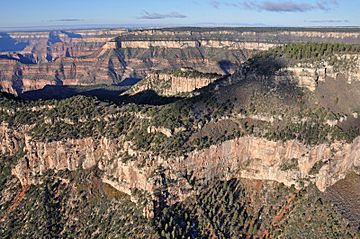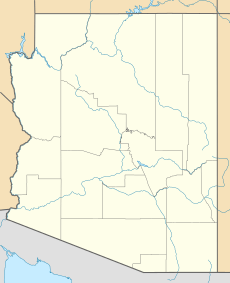The Dragon (Arizona) facts for kids
Quick facts for kids The Dragon (Arizona) |
|
|---|---|

east aspect (1/3 north region ridgeline)
(upper canyon tributary of Dragon Creek) |
|
| Highest point | |
| Elevation | 8,105 ft (2,470 m) |
| Prominence | 325 ft (99 m) |
| Parent peak | Kaibab Plateau (8,701 ft) |
| Geography | |
| Location | Grand Canyon Coconino County, Arizona, US |
| Parent range | Kaibab Plateau Colorado Plateau |
| Topo map | USGS Shiva Temple |
| Geology | |
| Type of rock | prominence-Kaibab Limestone-(forested tableland) and Kaibab Limestone, Toroweap Formation, Coconino Sandstone, Hermit Formation |
The Dragon is a tall mountain peak in the amazing Grand Canyon in Arizona, USA. It stands 8,105 feet high! This peak is located in Coconino County.
The Dragon is found north of a place called the Hindu Amphitheater. It's about 4.5 miles north-northwest of Shiva Temple. It's also about 2.5 miles north of Dragon Head. The Dragon and Dragon Head are connected on a long ridgeline. Dragon Head is at the very end of this ridgeline. These two landforms create two canyon areas where water flows. Dragon Creek is on the east side, and the upper part of Crystal Creek (Arizona) is on the west side.
Pictures of The Dragon and Dragon Head were taken from the air. These photos helped with studies about flight paths over the Grand Canyon.
What Is The Dragon Made Of?
The top part of The Dragon is made of a rock called Kaibab Limestone. This layer is about 250 to 300 feet thick. It's a hard, whitish rock that forms cliffs. Because it's so strong, it supports a flat area on top. This flat area is covered with a forest of Ponderosa Pine trees.
Below the Kaibab Limestone is a larger rock layer called the Toroweap Formation. This rock forms slopes, not cliffs. It has some plants growing on it. There are also many areas with loose rock and dirt from erosion. You won't see clear cliffs in this section.
The Toroweap Formation sits on top of a very tall cliff. This cliff is about 400 feet high and is made of Coconino Sandstone. The Coconino Sandstone is usually buff (a yellowish-brown) or reddish-white in color.
Underneath the Coconino Sandstone is a thick layer called the Hermit Formation. This rock is also known as Hermit Shale. Its slopes have plants, and you can see large sections of burnt-red-brown rock debris from it.



